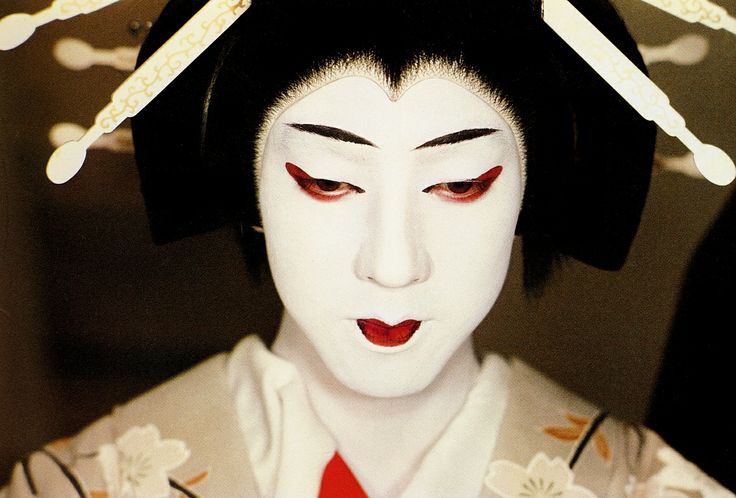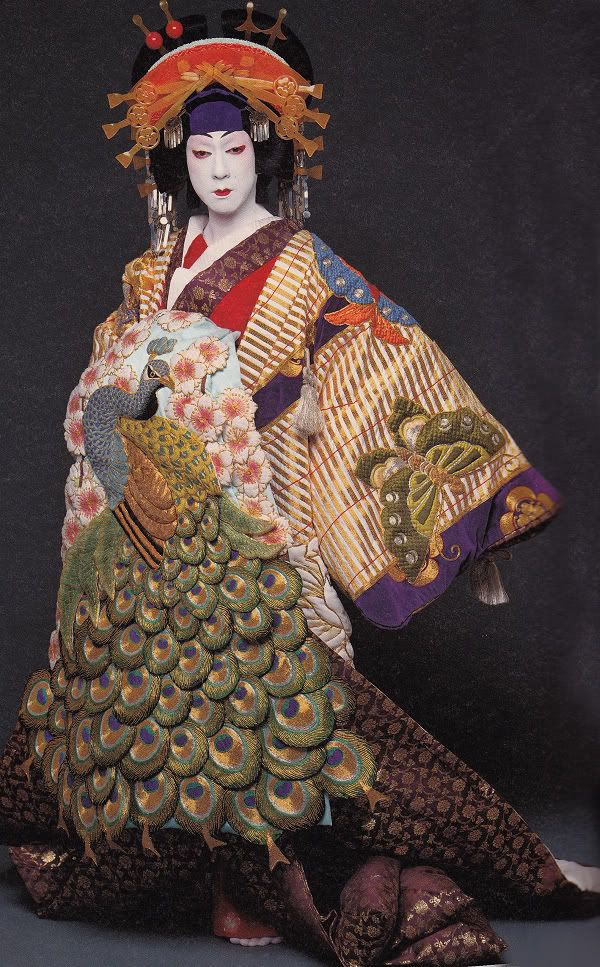The 20th-century writer and scholar of Japanese theatre, Faubion Bowers, noted for being the saviour of Kabuki, wrote in 1956 that ‘the genius of Kabuki lives in its actors and their manifold skills – of stylisation, of imitating puppets or animals, of realism, and of course, since Kabuki is a synthesis of the arts of dance and drama and music, of dancing, of playing musical instruments and of singing. And most actors, as a special favour to their fans, can draw a creditable picture or compose an exquisite poem.’ (Faubion Bowers, Theatre In The East, 1956). This feat of formidable flexibility has inspired me to write Seven Sages of the Kabuki Stage, a series of seven articles each focusing on an individual Kabuki actor. Since childhood I have been fascinated by the meeting point between being offstage and being onstage. When I performed in Tosca at Opera Holland Park in 2008, I was thirteen and remember quietly observing the star principle, Amanda Echalaz, as she emerged from her dressing room moments before the climactic final Act. Dressed in full costume and with a toothbrush in hand, I was flummoxed by just how poised, relaxed and at ease she was. She could have been at home on a Friday evening making herself tea. Yet in less than a minute she would be pouring petrol over a car she was standing on top of and setting herself alight whilst belting the final Puccini aria in front of an audience of over 1,000 people. 'Kabuki seems to me to have the perfect balance between sensuality and ritual which are the two poles of Japanese culture', (Alex Kerr, Lost Japan, 1983) and so I am delighted to lead you into this artform which sprung from The Floating World. Over the coming weeks, I will share with you my experiences of being backstage with Kabuki actors, seeing Kabuki live in Japan for the first time as well as my research into the artform that aims to explore this idea further. I shall begin the series by lifting the veil on the legendary actor Tamasaburo Bando V who has had a monumental impact not just on the development of Kabuki but also on the evolution of theatre, dance, music and visual art at a global level.

Tamasaburo Bando V is one of the all-time great Kabuki actors of the ‘onnagata’ style (a male actor who performs female roles). Still performing today, he was born on 25th April 1950 and as a baby suffered from polio which gave him a slight limp. The doctor suggested that traditional dance would be a good form of therapy - and, inadvertently, Tamasaburo was set on the path toward the Kabuki stage. Aged four, he began taking dance lessons at the Fujima School, where Kanshie Fujima, the wife of the Kabuki actor Morita Kanya XIV, was a master of Nihon Buyo. Kabuki, an almost perfectly preserved remnant of Japan’s feudal past, is dominated by a handful of old families. Actors are ranked according to the importance of their hereditary names like barons and dukes in the peerage, and most of the stars today are blood descendants of earlier actors. Although not born into the Kabuki world, at the age of six Tamasaburo was adopted by Morita Kanya XIV. He appeared as a child actor under the name of Bando Kinoji and started living in the Morita household instead of returning to the home of his parents each night. From then on his entire life has been devoted to the stage and his practice which includes playing the shamisen, dancing, kumadori (stage make-up), the Japanese tea ceremony and Ikebana (flower arranging). At fourteen he received the name Tamasaburo Bando and decided to specialise in the onnagata style of acting, which to be successful in he says, requires “the firm will and determination of the individual, an enabling and supportive environment, and, of course, you need to have hin (class or sophistication). Hin is very important — it’s all too easy to create something that has no hin.”

In March 1967, aged seventeen, Tamasaburo caught the eye of the public with his appearance in the play Sakura Hime Azuma Bunshō (The Scarlet Princess of Edo), originally written by Tsuruya Namboku IV in 1817 at the end of the Tokugawa era. Yukio Mishima adapted the play especially for him and teenage girls besieged the stage door of Japan’s National Theatre. It was the first time in over a hundred years that a Kabuki actor had become a popular star. Faubion Bowers described Tamasaburo’s meteoric rise to fame as “simply incredible”, explaining that “Kabuki used to be terribly restrictive. You had to be in your 40's or 50's before you were allowed to be very popular.” Unlike other actors, he had achieved fame outside of Kabuki as his face was everywhere – on TV, posters and in advertisements. For his cult of female followers at that time, Tamasaburo’s attraction was not necessarily sexual. ''His beauty is not threatening to women, not something to be jealous about, because he is a man.'' Remarked 22-year-old fan Mari Kataoka, ''You can learn very beautiful feminine gestures by watching Tamasaburo.'' (Steve Lohr, The New Face of Kabuki, New York Times Magazine, May 30th, 1982). In April 1973 while on tour in Japan, David Bowie did precisely that. He met Tamasaburo, who had just turned twenty-three, (three years younger than Bowie), for the first time inside the Kabuki actor’s dressing room and asked if he could watch him apply his kumadori (stage-makeup). This was a hugely transformative experience for Bowie as it inspired the invention of his own androgynous stage persona, Ziggy Stardust, which paid homage to the beauty of the onnagata.
One of Tamasaburo Bando’s most outstanding qualities as an actor is this sense of aesthetic beauty which he is able to express through form and movement. In Yukio Mishima's short story, Onnagata, he describes this feminine power communicated in Kabuki as "a seductive evil which leads men astray and makes them drown in an instant of beauty."' With other onnagata actors, one can easily tell that they are men, but not Tamasaburo. He really looks like a woman. His face, body and gestures are all slightly more feminine than those of the other female impersonators and he looks like a moving painting on-stage. Speaking about his creative approach to performing onnagata roles in Daniel Schmid’s documentary film, The Written Face, Tamasaburo says, “I gather up knowledge about women. I watch different women: this is how they react, this is how they place their hand on their hair when they are thinking. I gather up this type of material and transform it.” In a craft that judges excellence by millimetre-accurate replication of movement, even the act of looking back or putting on a costume requires meticulous planning and Tamasaburo 'will spend hours with the kimono dyers discussing the precise shade of purple a certain kimono should be, what colour the actor Kikugoro VI (‘the Great Sixth’) used or what is chic or not chic by standards of the Edo era.' (Alex Kerr, Lost Japan, 1983) In The Written Face, Tamasaburo explains that although he performs female characters onstage it is "with the eyes and feeling of a man, like a man painting a portrait of a woman. This is how I give shape to an onnagata role. I try to portray the ideal image of a woman in the same way a male writer describes feminine feelings from the standpoint of a man. I do not represent a woman. I suggest the essence of a woman." Such obsessive attention to detail means that in his dressing room just before performance a churchlike atmosphere prevails. Alex Kerr, a close friend of Tamasaburo who spent five years ‘practically living’ backstage at the Kabuki-za theatre became immersed in the drama and rituals of this sacred world. In his book, Lost Japan, he describes the ecstasy of seeing Tamasaburo perform onstage for the first time at the Shinbashi Enbujo Theatre in Tokyo in the dance, Sagi Musume (Heron Maiden):
The beginning of the dance was quiet. Sagi Musume, dressed in a pure white kimono, a white hood over her head, turned slowly at the centre of the stage, her movement so smooth and perfectly controlled that she seemed like a marble statue. Though Tamasaburo had yet to show his face, he had already conjured up a quiet, twilt, snow-covered world. The hood fell, revealing the pure face of an angel, radiantly white. The audience gasped; this was not the usual onnagata. Impossible to describe, the beauty of Tamasaburo is almost a natural phenomenon, like a rainbow or a waterfall.

Alex also remembers in Lost Japan how he was once translating for Tamasaburo when someone asked him, “Why did you want to become an actor?” To which Tamasaburo answered, “Because I longed for a world of beauty beyond my reach.” From a career perspective nothing has ever seemed beyond the reach of Tamasaburo who has embarked on a myriad of international art projects whilst maintaining his rank as a premier Kabuki actor. He has starred in and directed a number of films including Yearning (1993), which was entered into the 43rd Berlin International Film Festival. He collaborated with friend and Ballet superstar Mikhail Baryshnikov in Dance With Three Drums and Flute in New York in 1999 and has taken on leading Shakespeare roles including Lady Macbeth and Desdemona. Tamasaburo was awarded the Praemium Imperiale International Arts Award in 2019, and despite recently turning 70, still performs leading roles and directs the world-renown performing arts company, Kodo.


Out of make-up, Tamasaburo is a tall, slender man who Alex Kerr describes as someone who ‘looks not much different from somebody one might sit next to on the train. In contrast with his sadness-tinged femininity of the stage, he is no-nonsense, cheerful, funny.’ In financial negotiations, Tamasaburo makes the important decisions himself, keeping close control over his affairs, and he is said to be an astute businessman. Recalling the day David Bowie visited his dressing room, Tamasaburo describes how “[after the performance] Bowie wanted to eat in a Japanese-style restaurant, so we dined at the Hanya-en, a Japanese restaurant that was the setting for Yukio Mishima’s novel After the Banquet. I remember how we sat in a large room surrounded by a corridor with sliding screens containing delicate pre-war glass, and how the three of us, myself, Bowie and the designer Kansai Yamamoto, leisurely enjoyed the Japanese meal. When I am on stage, I wear showy costumes and makeup, but in daily life I try to wear ordinary clothes. You could call it the sacred and the profane. Bowie at that time, however, dressed as a stylish rock star even offstage. I wondered if he ever got tired of that style.” Kabuki actors spend a greater percentage of their life onstage than almost any other actors, and the prolific Kabuki actor Nakamura Kichiemon I (1886-1954) once remarked to Faubion Bowers that “The stage becomes the reality and the rest of the world a dream”. Perhaps this is one of the reasons why Tamasaburo insists on the importance of “separating one’s art from the everyday because [especially as an onnagata actor] one is trying to create something that is so alien to oneself in so many ways.” (Ryoko M. Nakamura, Japan Times, March 13, 2009)
"I have nothing to say. That is why I dance and act. Which is where everything I wish to express can be seen. Things that are impossible to say. The substance of what I want to say lies in the act of looking back or putting on a costume. Of course, I use language when I try to explain my feelings, or ideas. I choose my words carefully, arrange and connect them as if editing a film. Nonetheless, words only have a secondary nature for me.”
- (Daniel Schmid, The Written Face, 1995)
__












Comments